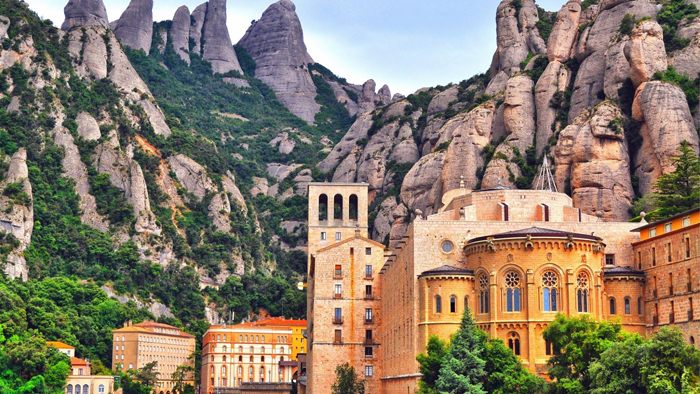

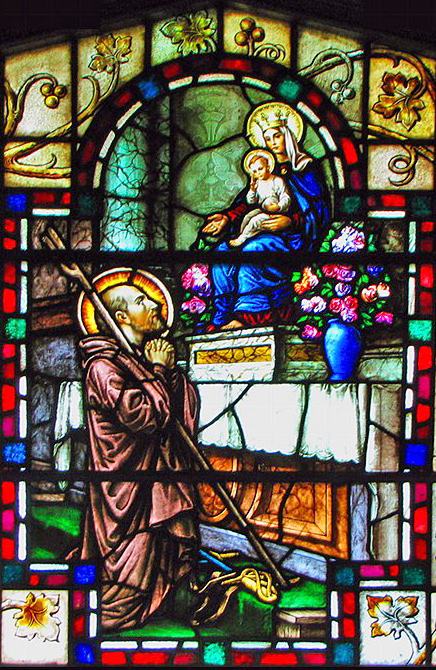 Barcelona, the second largest city of Spain and the capital of Catalonia, stands on the Mediterranean,
and from a remote period of antiquity has been a place of considerable importance. It is supposed to have been founded by
the famous Carthaginian General, Hamilcar Barca, from whom it has derived its name. A short distance from this ancient
city is the mountain of Montserrat, famous for the miraculous image of Our Lady so long concealed in its rocky recesses,
and of which the granite mountain alone knew the secret; famous also as being the spot where St. Ignatius of Loyola,
having laid aside forever the vain trappings of worldly knighthood, passed his lonely vigil of penance and prayer before
assuming the arms of a knight of the Cross (image at left).
Barcelona, the second largest city of Spain and the capital of Catalonia, stands on the Mediterranean,
and from a remote period of antiquity has been a place of considerable importance. It is supposed to have been founded by
the famous Carthaginian General, Hamilcar Barca, from whom it has derived its name. A short distance from this ancient
city is the mountain of Montserrat, famous for the miraculous image of Our Lady so long concealed in its rocky recesses,
and of which the granite mountain alone knew the secret; famous also as being the spot where St. Ignatius of Loyola,
having laid aside forever the vain trappings of worldly knighthood, passed his lonely vigil of penance and prayer before
assuming the arms of a knight of the Cross (image at left).
This celebrated mountain presents a curious spectacle to the traveler's eye, consisting as it does of a number of rocky, cone-shaped peaks, rising one above the other until they terminate in a cluster round the summit (image above). This group of cones, seen from a distance, bears a fanciful resemblance to the teeth of a saw; and to this the mountain owes its name of Montserrat, or the serrated mountain. Its height is estimated at nearly 4,000 feet, and its circumference around the base at about twelve miles. Montserrat is of granite formation, and rich in medicinal plants. Although very few streams are to be met with, one cannot but admire the richness and luxuriance of the undergrowth. The atmosphere is delightfully invigorating, and the view from the summit simply magnificent, amply rewarding the toil of the ascent. It is said that on a clear day the islands of Majorca and Minorca, one hundred and fifty miles distant, are distinctly visible even from some of the lower cones.
With regard to the miraculous image of Montserrat (image on homepage and below), tradition tells us that it was the work of the Evangelist St. Luke, executed when he was in Jerusalem; for which reason it received at first the name of La Jerosolimitana (The Lady of Jerusalem – it later has been commonly called La Moretana, due to its having darkened with age.) The old chronicles go on to relate that the Prince of the Church, St. Peter, when passing through Spain, entrusted the image to the first Bishop of Barcelona, St. Etereo, whose love for our Blessed Mother was beyond all measure. From that time until the seventh century the holy image was held in veneration, not only in Barcelona, but throughout all Catalonia; and wondrous were the graces and favors said to have been bestowed upon those who sought help and consolation at Our Lady's Shrine.
But in the seventh century the Moors entered Spain, carrying death and devastation wherever they appeared. The Christians of Barcelona were stricken with fear, not so much for their lives and homes as at the thought that the precious treasure confided to their city by the Apostle might fall into the hands of the heathen. For three years they defended themselves bravely against the infidels; but, finding they could no longer resist, they determined to remove the holy image to a secure hiding-place, where it would be safe from the insults and profanations of the conquerors. Consequently, the Bishop and the governor of the city, aided by a trusty band, with the utmost secrecy carried the object of their love and veneration to one of the most hidden and inaccessible caves of Montserrat. The translation took place on April 22, 718; and a full account of the origin of the miraculous image and the cause of the removal was drawn up, and carefully deposited in the city archives.
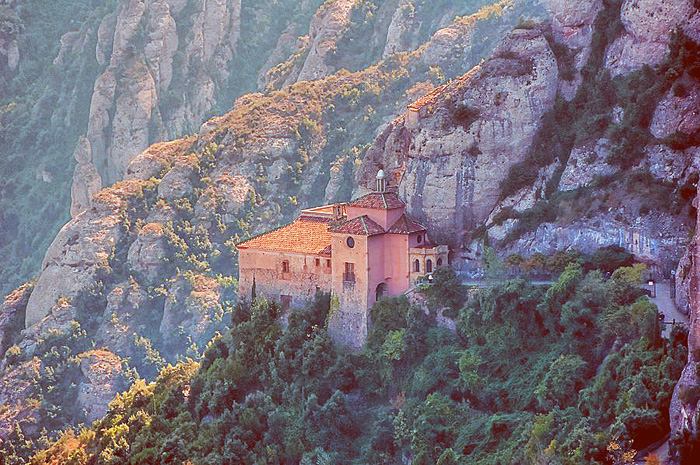
The years rolled on. The inhabitants of Barcelona never lost sight of the tradition of the wondrous image which had passed from their midst, but by degrees all knowledge of its secret resting-place was lost in the midst of time.
It was the year of Our Lord 890. One Saturday evening some shepherd boys from Monistrol, a village at the foot of Montserrat, were tending their flocks on the mountain. Suddenly one of them noticed a brilliant light issuing forth with such dazzling splendor as to illuminate a considerable portion of the mountain around, causing it to stand out in startling distinctness against the somber darkness of the night. He drew his companions' attention to the strange occurrence, and they gazed in silent, awestruck wonder. At the same time they heard strains of the sweetest music, like angelic harmonies.
The youths quickly told their parents of what they had seen. The old people, somewhat incredulous, went to the mountain only on the following Saturday, and witnessed the phenomenon. Filled with awe, the peasants hastened to acquaint the parish priest of Olesa with what was happening on Montserrat. The good priest, in his turn doubting their statement, repaired without delay to the mountain. Again the wondrous light streamed from the cave and celestial harmony filled the air.
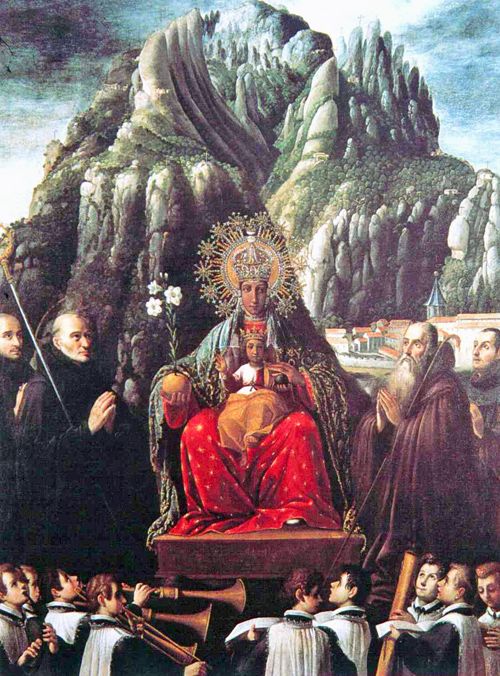 Up to this time no one had dared to penetrate to the spot whence the marvels issued. The rector of Olesa, taking with him
those who had been witnesses of these extraordinary manifestations, went to Manresa, and laid before the Bishop of the
diocese a detailed account of the sights and sounds seen and heard on Montserrat. The Bishop, much impressed with the
narrative, determined to investigate the matter. On the following Saturday he, with a number of his clergy, the rector
of Olesa, and the other privileged persons who had seen the heavenly sight, went in solemn procession, just as the evening
Angelus was ringing, to that part of the mountain where the wonder had taken place. The shades of night had scarcely fallen
when a light of unearthly effulgence streamed from the cave, and at the same time music of ecstatic sweetness and angelic
canticles were heard. The lights and harmonies continued until midnight, when the glorious radiance faded, leaving the
rocky peaks in blackest darkness; and the heavenly strains also died away, to be succeeded by the deep silence of night.
Up to this time no one had dared to penetrate to the spot whence the marvels issued. The rector of Olesa, taking with him
those who had been witnesses of these extraordinary manifestations, went to Manresa, and laid before the Bishop of the
diocese a detailed account of the sights and sounds seen and heard on Montserrat. The Bishop, much impressed with the
narrative, determined to investigate the matter. On the following Saturday he, with a number of his clergy, the rector
of Olesa, and the other privileged persons who had seen the heavenly sight, went in solemn procession, just as the evening
Angelus was ringing, to that part of the mountain where the wonder had taken place. The shades of night had scarcely fallen
when a light of unearthly effulgence streamed from the cave, and at the same time music of ecstatic sweetness and angelic
canticles were heard. The lights and harmonies continued until midnight, when the glorious radiance faded, leaving the
rocky peaks in blackest darkness; and the heavenly strains also died away, to be succeeded by the deep silence of night.
The Bishop ordered that the next morning, at break of day, the mountain should be scaled and the cave searched. This proved a difficult task; but the men, filled with enthusiasm, at great risk succeeded in reaching the cave. On entering they perceived a most delightful fragrance; and advancing farther, were rewarded by the discovery of the holy image, which had lain hidden in the dark recesses of the cave for so many years.
On hearing of their discovery, the Bishop, filled with joy, announced his intention of proceeding at any risk to the spot. A procession was formed, in which were carried innumerable wax lights, and after some time the cave was reached. The Bishop knelt and gave thanks to God for the marvelous revelation. He then reverently took the holy image with the intention of placing it in the Cathedral at Manresa, that it might there receive the veneration of the faithful. But when the procession, on its return, reached the spot where the Church of Our Lady of Montserrat now stands, it was brought to a sudden standstill: those composing it finding themselves unable to proceed or to retrace their steps, nor could they move the statue. Perceiving this, the Bishop made a vow to build a chapel in honor of the Blessed Virgin in that particular spot, and the rector of Olesa vowed that he would spend the remainder of his life there in meditation and prayer. Both vows were piously fulfilled. A magnificent chapel was built, the charge of which was given to the rector conjointly with another priest.
Soon after the building of the chapel, Jofre Villoso, Earl of Barcelona, in thanksgiving for the miraculous restoration of his daughter to life, founded a convent at Montserrat for nuns of the Order of St. Benedict, of which convent his daughter afterward became Abbess. On her death, Borell, surnamed the Good, Count of Barcelona, representing to the Pope that, on account of the vast numbers who flocked to the shrine, a monastery would be more suited to the requirements of the place, obtained permission to establish some Benedictine monks there, and the nuns were transferred to Barcelona.
At first only four simple hermitages housed the monks. Some time later a monastery was established, which obtained its own abbot in 1025. It was built about half-way up the mountain on the only available space. There were usually around seventy to eighty monks, twenty-eight lay brothers, besides choir boys, a physician, a surgeon, and several servants. On the annual Feast of Our Lady of Montserrat the number of pilgrims often ran up to 5,000. All who applied at the monastery were supplied with food gratis for three days, and the sick were cared for in the hospital. The greater number of the pilgrims found shelter in the rocks and caves.
In different parts of the mountain, generally in the most picturesque spots, were erected thirteen hermitages (ermitas), each the abode of a holy recluse, who passed his life in continual penance and prayer. These venerable solitaries were subject to the abbot of the monastery at Montserrat, who received their vows, and appointed to each his ermita. They took the same vows as the other monks, with the additional vow never to leave the mountain; they practiced perpetual abstinence from meat – their food consisting only of bread, salted fish, vegetables, eggs and cheese. From the third of September until Easter they fasted every day (except Sundays and great Feasts); the rest of the year they fasted two or three time each week. In addition, they were bound to long hours of prayer, mental and vocal. Their recreation was employed in making small crosses, which they gave to the pilgrims who sought them in their solitude. These crosses were held in great veneration on account of the indulgences attached to them by the Sovereign Pontiffs. Once a year the hermit of San Benito invited the twelve others to dine with him; with this exception, their lives were passed in strict solitude. At stated times a lay-brother of the monastery loaded an ass with thirteen portions of food; the animal, trained to his work, started off and without any guide, sought out each ermita; and then, unburdened of his load, returned to the monastery.
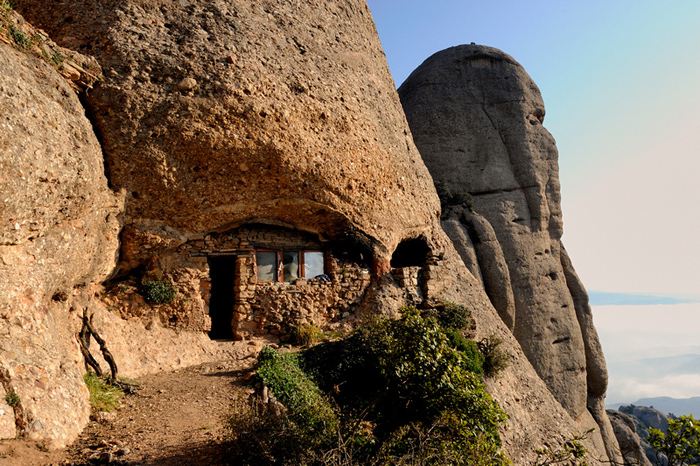
As the ages rolled away, the fame of the miraculous image of Our Lady of Montserrat increased more and more. Pilgrims flocked in vast numbers from all parts of Europe to lay the homage of their devotion at Mary’s Shrine. Those were the days of faith, and many were the privations and sufferings endured, even by the highest rank, to reach the favored spot – some trudging barefoot and bleeding over the hard rocks. Kings and queens esteemed themselves fortunate in making the pilgrimage, and carried with them, as votive offerings, lamps and vessels of gold and silver adorned with jewels.
At length it was found that the old church which had sheltered the holy image for seven hundred years could no longer contain the ever-increasing stream of the devoted clients of the Queen of Heaven. It was therefore resolved to replace the old structure by a new and magnificent basilica, the foundations of which were laid in 1492; but for a considerable time the work proceeded no further. Finally it was resumed in 1560, and was brought to a successful termination in 1592. The Church of Our Lady of Montserrat was consecrated under the invocation of Our Blessed Lady in the Mystery of the Annunciation, of which there was a representation on the façade.
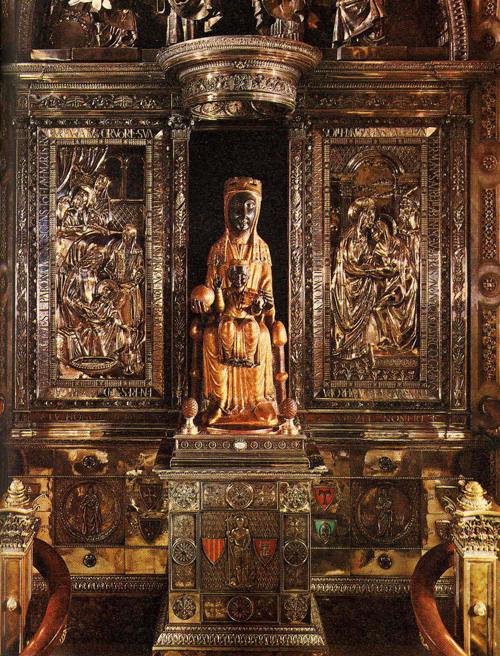 The sacred image was removed to this new and magnificent shrine with great solemnity on the 9th of July,
1599 – His Majesty Philip III taking part in the ceremonies – and was placed over the high altar. Before it were forty wax
candles of great size, but these were used only on great festivals; fifty silver lamps were kept burning night and day.
The image is of full size, and represents Our Lady in a sitting posture with Her Divine Child in Her lap. She wears a crown
and in Her right hand holds a globe, out of which springs a bunch of lilies. Her features are beautiful, and have an
expression of great sweetness and benevolence. The Divine Infant is also represented with a crown, and in His left hand a
globe; His right hand is raised as if in the act of blessing. It is impossible to avoid being struck with the marvelous
resemblance between the Mother and Child. The whole is carved in wood which has darkened with age.
The sacred image was removed to this new and magnificent shrine with great solemnity on the 9th of July,
1599 – His Majesty Philip III taking part in the ceremonies – and was placed over the high altar. Before it were forty wax
candles of great size, but these were used only on great festivals; fifty silver lamps were kept burning night and day.
The image is of full size, and represents Our Lady in a sitting posture with Her Divine Child in Her lap. She wears a crown
and in Her right hand holds a globe, out of which springs a bunch of lilies. Her features are beautiful, and have an
expression of great sweetness and benevolence. The Divine Infant is also represented with a crown, and in His left hand a
globe; His right hand is raised as if in the act of blessing. It is impossible to avoid being struck with the marvelous
resemblance between the Mother and Child. The whole is carved in wood which has darkened with age.
In 1811 the monastery was almost entirely destroyed by the Napoleonic troops. Only the Romanesque portal and fragments of the Gothic gallery were preserved intact. Fortunately, the main treasure of the monastery – the image of Our Lady – was hidden by the faithful in advance. After several decades of neglect, in the middle of the 19th century, the Benedictines, actively supported by the faithful of Catalonia, began to restore the monastery – the work occupying nearly a century. In 1881 Pope Leo XIII declared the Virgin Mary of Montserrat the Patroness of Catalonia, and raised the restored monastery church to the rank of minor basilica.
In 1944 it was decided that a new throne room
would house the image of Our Lady of Montserrat above
the high altar. It is accessible to pilgrims by a stairway. The statue of the Virgin Mary is seated upon an incredibly
ornate throne covered in Venetian mosaics (image left). She was enthroned on April 27, 1947, although work on the throne room was not
completed until 1954. April 27 therefore became the principal Feast of Our Lady of Montserrat, although some older sources
give November 24 as Her Feast – probably an anniversary from more ancient times.
Contact us: smr@salvemariaregina.info
Visit also: www.marienfried.com